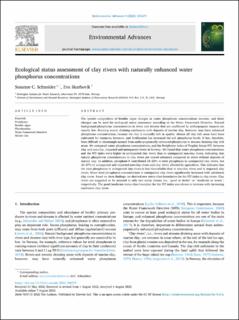| dc.description.abstract | The species composition of benthic algae changes as water phosphorus concentrations increase, and these changes can be used for ecological status assessment according to the Water Framework Directive. Natural background phosphorus concentrations in rivers and streams that are unaffected by anthropogenic impacts are usually low. Running waters draining catchments with deposits of marine clay, however, may have enhanced phosphorus concentrations, because the clay is naturally rich in apatite. Almost all clay rich areas have been cultivated for centuries, however, and fertilization has increased the soil phosphorus levels. It has, therefore, been difficult to disentangle natural from anthropogenically enhanced phosphorus in streams draining clay rich areas. We compared water phosphorus concentrations, and the Periphyton Index of Trophic Status PIT, between clay and non-clay, impacted and unimpacted rivers in Norway. We found that water phosphorus concentrations and the PIT index were higher in unimpacted clay rivers than in unimpacted non-clay rivers, indicating that natural phosphorus concentrations in clay rivers are indeed enhanced compared to rivers without deposits of marine clay. In addition, phosphate-P contributed 18–23% to total phosphorus in unimpacted clay rivers, but 33–37% in unimpacted and impacted non-clay rivers and clay rivers affected by agriculture. This indicates that the total phosphorus in unimpacted clay rivers is less bioavailable than in non-clay rivers and in impacted clay rivers. Water total phosphorus concentrations in unimpacted clay rivers significantly increased with catchment clay cover. Based on these findings, we derived new status class boundaries for the PIT index in clay rivers. Clay rivers are suggested to be assessed in only two status classes, i.e., “good or better” or “moderate or worse”, respectively. The good/moderate status class boundary for the PIT index was shown to increase with increasing catchment clay cover. | en_US |

